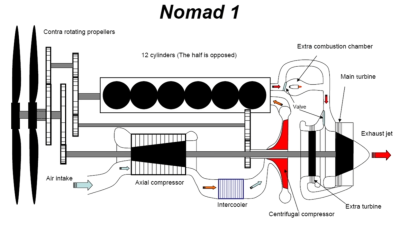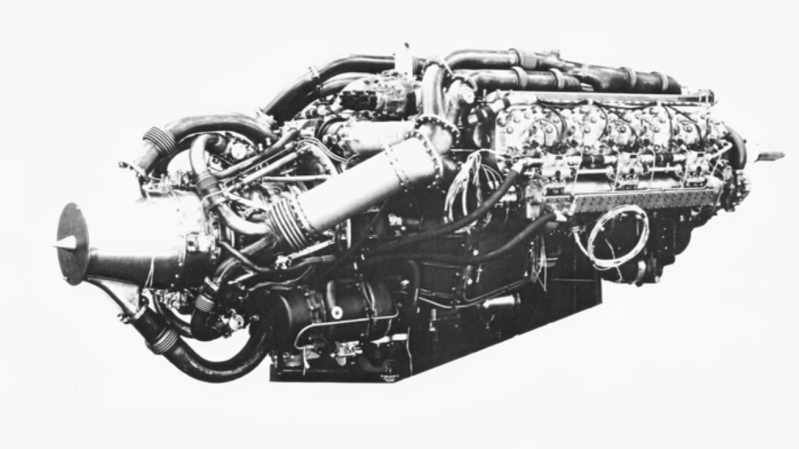From 1945 to 1955, a British aeronautical company called Napier & Son produced not just one but two versions of an intricate hybrid piston engine, which they named the Napier Nomad. The post-World War II era saw the development of several fascinating (and highly complex) piston-powered aeronautical engines alongside the emerging gas turbine engine designs. During this period, gas turbines were inefficient, unreliable, and primarily used for military applications. The (then) British Ministry of Supply commissioned the design and creation of a more fuel-efficient piston engine for aeronautical purposes, both military and civil, aiming to achieve gas turbine-like power while maintaining piston engine efficiency. Quite the challenge!
The specification aimed for 6000 hp and optimal fuel efficiency for long-range use. Napier knew gas turbines were limited by maximum operating temperature, constrained by available materials, which increased fuel consumption and reduced range. Piston engines operated at higher peak temperatures. They considered combining both principles to create a superior design, a concept suggested by aeronautical engineer Sir Harry Ricardo, who had consulted for Napier on other projects. Their complex solution was to build a gas turbine with a two-stroke diesel engine as the combustion chamber, merging the benefits of both.
This liquid-cooled, horizontally opposed 12-cylinder two-stroke diesel engine featured a piston-ported design with shared crank pins in a fork and blade arrangement. Its two-stroke configuration vastly reduces pull loads on the conrods, allowing for lighter one-sided half bearings. The six-throw crankshaft ensured excellent primary and secondary balancing.

The piston-ported design of the Nomad relies on a supercharger for efficiency, using a crank-driven centrifugal compressor. Notably, the three-stage exhaust turbine also drives the same compressor shaft. One propeller is gear-driven from the diesel engine, while the second contrarotating propeller is powered directly from the compressor shaft through a second gearbox. It’s quite a unique machine!
To enhance take-off power, the engine is equipped with a kind of afterburner. This feature utilises a fuel injector in the exhaust of the diesel engine to increase the flow of exhaust gases, thereby generating more power for the turbine and providing additional thrust. To maximise efficiency and extract every possible bit of power from the exhaust gases, a valve can be opened to direct some of these gases to a secondary exhaust turbine that operates alongside the main unit. Despite the early optimistic power requirement, the Nomad I produced a total power of 3000 hp, with an additional 319 lbf of usable thrust contributed by the exhaust turbine.
We won’t go into the second version of the (never constructed) engine, the Nomad II; you can watch the video yourselves for that. Suffice it to say, simplification was possible, with yet more innovation. It’s a pity the whole program was cancelled and the engines never saw any usage beyond initial test flights.
If this engine sits firmly at one end of the complexity scale, then this DIY single-cylinder two-stroke surely sits at the other? And whilst we’re still thinking about piston engines, does anyone remember this neat free-piston engine?
Images supplied by the Napier Power Heritage Trust
Thanks to [Stephen Walters] for the tip!
















Nomad 2 was constructed. It produced 3150hp and had the lowest specific fuel consumption of any engine up to that time. Wikipedia page has more info and a picture of it.
And don’t forget their Napier Deltic
https://en.wikipedia.org/wiki/Napier_Deltic
Reading through the description and noting all the complexity i was already cringing, then I got to the picture showing the contra rotating propeller and about had a stroke. From an engineering perspective this thing is super cool, but I have to imagine it would have been a reliability nightmare.
Agreed!
This engine is new to me, and I literally had to screenshot and draw out the gear rotation directions to put together in my mind what happens.
I initially thought the gearing was redundant, but nope, it’s all for the counter rotating prop. When I looked closely, I realized the main prop shaft was split with an inner and outer sleeve. The illustration would be better served if it the moving parts were colored to show the separation.
I do disagree with you a bit in the complexity being a nightmare, sometimes in the name of efficiency, it’s necessary. It just takes time to understand and become familiar with them.
Take a SMPS for example. Complex as hell compared to a simple transformer and rectifier, but the weight and efficiency make it totally worth it. After years of refining, quality ones are pretty dang reliable. Even old school 60hz wall wort power supplies can fail due to a cheap rectifier or voltage regulator going bad.
For a really good analysis read the chapter in LJKSetright’s book “The Power to Fly”.
In his book “Some Unusual Engines” Setright had a memorable phrase about the development of turbine engines, that made me realize there was actually a sort of continuum between piston and turbine designs. I paraphrase what he said: if you develop the turbine power recovery section of a piston engine enough, you end up using the pistons as merely a source for hot air for the turbine, and by so doing, you’ve unintentionally invented the jet engine.
Napier always had a thing for really complicated engines.
Sometimes, they even worked.
see: the Napier Deltic: https://en.wikipedia.org/wiki/Napier_Deltic
The operational diagrams are… informative…
Having a turbocharged engine, but using the turbo to propel you along.
Certainly an interesting way to invert the solution.
Sir Harry Ricardo was quite an inventive chap as far as modern engines go – his company are still going in the UK and still doing R&D for the automotive & aerospace industry;
https://www.ricardo.com/
And here was me thinking the Griffon was the last word in aero piston engines…
Pistons are a great way to increase pressure. Recips are still run on gas pipelines to keep the pressure up. This is a very cool combination. It might be called a gas turbine with a reciprocating final stage compressor.